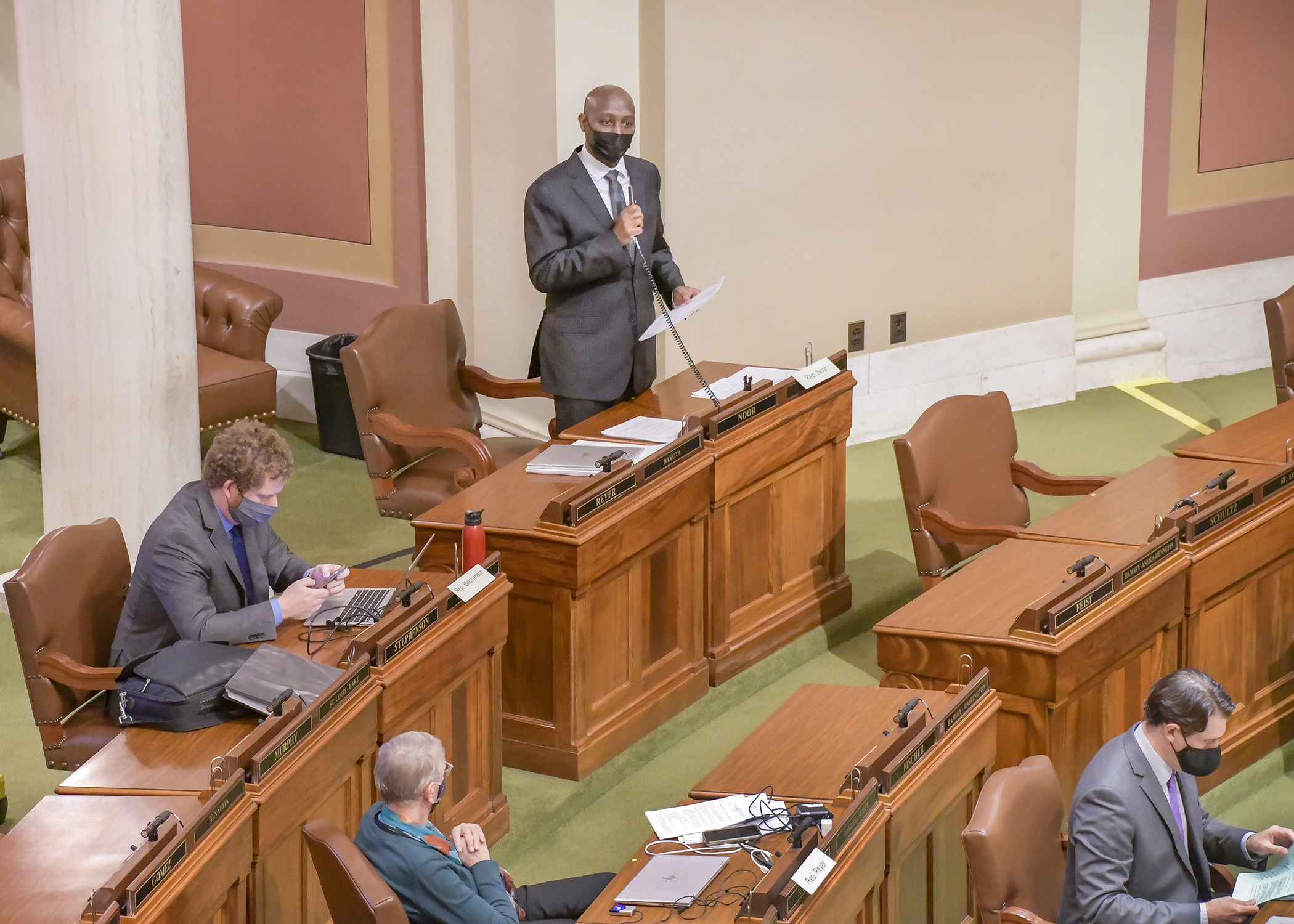Omnibus workforce bill — praised for protecting workers, criticized as bad for business — passes House

The omnibus workforce and business development finance and policy bill has passed the House, after being praised by DFLers for protecting workers and criticized by Republicans as bad for business owners.
Sponsored by Rep. Mohamud Noor (DFL-Mpls), HF1342/SF1098* was passed 69-64, as amended, Tuesday and now heads back to the Senate, where Sen. Eric Pratt (R-Prior Lake) is the sponsor.
The Senate passed its version 37-30 April 15. A conference committee is expected to work out the differences.
"We will only fully be beyond the economic struggles of COVID-19 when all Minnesotans are truly able to once again succeed and thrive," said Rep. Rob Ecklund (DFL-International Falls). "The investments and bold strategies in this bill will help us reach that vision."
Republicans said the bill does not help to reopen businesses or provide them economic relief and creates more mandates at an especially bad time.
"This is a jobs killer," said Rep. Matt Bliss (R-Pennington). "There's absolutely no provisions in here for job creators."
The bill would adjust fiscal year 2021 General Fund spending and appropriate $297.5 million from the General Fund next biennium. Among the most notable spending proposals, it would allocate:
- $50 million in fiscal year 2021 for grants to small businesses affected by COVID-19, splitting the money evenly between Greater Minnesota and the Twin Cities metropolitan area;
- $10 million for local community child care;
- $5 million for LAUNCH Minnesota;
- $2.1 million for microenterprise development; and
- $1.1 million in fiscal year 2021 for a grant to the Northeast Entrepreneur Fund, contingent on the organization repaying an outstanding $1.1 million loan to the Department of Employment and Economic Development.
A significant portion of the bill is the family and medical benefits program, which is also moving separately as HF1200. Sponsored by Rep. Ruth Richardson (DFL-Mendota Heights), it would establish a state-run insurance program to partially reimburse lost wages for workers taking medical or family leave.
Modeled after the state’s unemployment insurance benefit program, the family and medical benefits program would provide partial wage replacement for up to 12 weeks per year for a worker’s own serious health condition, and up to 12 weeks per year for care of a family member’s serious health condition.
Noor said the bill represents “a major shift” in how workforce development grants would be structured and distributed. For example, it would require 65% of the money in the workforce development fund be prioritized for individuals who are Black, Indigenous, or People of Color, while maintaining a 50/50 balance between Greater Minnesota and metro area recipients.
Unemployment insurance changes
Several changes to unemployment insurance and compensation would be made.
The definition of reemployment assistance training would be modified by allowing more types of training — such as English as a second language, high school equivalency, or basic computer skills — to be pursued while still qualifying for unemployment insurance.
The bill would modify state law that requires 50% of the weekly equivalent of Social Security old age or disability benefit be deducted from an applicant’s weekly unemployment benefit payment if the applicant is receiving, has received, or has filed for Social Security benefits.
Contracted school workers, like bus drivers and hourly employees, who are unemployed between school terms would qualify for unemployment benefits if they otherwise meet eligibility requirements.
High school students would qualify for unemployment insurance benefits if they otherwise meet eligibility requirements. High school students are now excluded from receiving unemployment benefits.
The bill would also classify certain COVID-19-related “leaves of absence” as being involuntary, so the leave would not make an applicant ineligible for unemployment insurance benefits.
Labor provisions
The bill includes multiple high-profile provisions aiming to provide protections to workers, including an earned sick and safe time proposal that has already passed the House.
Among the other worker-protection measures, the bill would:
- ban employers from passing on tip-related credit card processing fees to employees and from requesting or using credit information as a condition of employment, hiring, firing or compensation decisions;
- require employers to provide nursing and lactating workers with paid break time to express milk;
- create a new requirement that at least 85% of the employees of any contractor working at an oil refinery must have experience with a registered apprenticeship program in the applicable trade;
- require shuttered hospitality businesses to notify laid-off workers when they reopen and rehire them to positions for which they are qualified before turning to new workers; and
- establish safety requirements for meat and poultry processing operations and workplaces.
Floor amendments
In addition to a delete-all amendment sponsored by Noor, House members debated seven amendments to the bill, three of which were adopted.
The most notable was the A2 amendment, offered by Rep. Kaela Berg (DFL-Burnsville), which would require all rooms in 20-plus-room hotels to have carbon monoxide alarms.
Berg sponsors a bill with the same requirements, HF2284.
- Session Daily writer Tim Walker contributed to this story
Related Articles
Search Session Daily
Advanced Search OptionsPriority Dailies
Ways and Means Committee OKs proposed $512 million supplemental budget on party-line vote
By Mike Cook Meeting more needs or fiscal irresponsibility is one way to sum up the differences among the two parties on a supplemental spending package a year after a $72 billion state budg...
Meeting more needs or fiscal irresponsibility is one way to sum up the differences among the two parties on a supplemental spending package a year after a $72 billion state budg...
Minnesota’s projected budget surplus balloons to $3.7 billion, but fiscal pressure still looms
By Rob Hubbard Just as Minnesota has experienced a warmer winter than usual, so has the state’s budget outlook warmed over the past few months.
On Thursday, Minnesota Management and Budget...
Just as Minnesota has experienced a warmer winter than usual, so has the state’s budget outlook warmed over the past few months.
On Thursday, Minnesota Management and Budget...